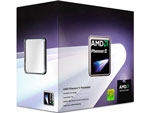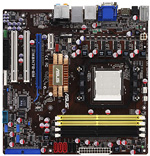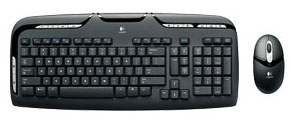AMD HTPC
Everyone asks for HTPC component recommendations, and then when we publish them readers can't wait to throw rocks at our recommendations. Perhaps this is because the HTPC, more than any other computer class, is a very personal machine. It needs to meet the specific needs and demands of the end users, who vary widely in what they plan to do with their new HTPC. So let's first talk about our concept in these two HTPC configurations.
We are assuming the user already has the HDTV (likely) or display he plans to feed, along with a sound system for that HDTV. The motherboards we recommend can reasonably feed audio signals for your Blu-ray movies, but they are not integrated audio amplifiers. Since most end-users are on cable or satellite for TV, we will make no recommendations at all for a TV tuner. Of the many possible uses of an HTPC the great majority of end-users store, play, and stream movies with their HTPC computers. That is mostly what their HTPC systems are used for and that is where we have concentrated our recommendations. In general the processing power in both systems has increased since our December 2009 guide, but costs have gone down a bit.
| AMD HTPC System | ||
| Hardware | Component | Price |
| Processor | MD Phenom II X3 710 (2.6GHzx3, 3x512KB L2, 6MB L3 Cache) |
$119 |
| Cooling | CPU Retail HSF | $- |
| Video | On-Board | $- |
| Motherboard | ASUS M3N78-EM | $90 |
| Memory | 4GB DDR2-800 - GSkill F2-6400CL5D-4GBPQ | $37 |
| Hard Drive | Western Digital Caviar Green WD10EACS 1TB SATA 3.0Gb/s Hard Drive - OEM | $105 |
| Optical Drive | LG BD/HD DVD / 16x DVD+/- RW GGC-H20L - Retail | $110 |
| Audio | On-Board | $- |
| Case | SILVERSTONE Black Aluminum/Steel LC13B-E ATX HTPC Case (After $15 Rebate) | $100 |
| Power Supply | PC Power & Cooling Silencer PPCS500 500W ATX12V / EPS12V SLI Ready CrossFire Ready 80 PLUS Certified Active PFC Power Supply - Retail (after $25 Rebate) | $50 |
| Base System Total | $611 | |
| Keyboard and Mouse | Logitech Cordless Desktop EX110 Black USB RF Wireless Keyboard & Optical Mouse | $30 |
| Operating System | Microsoft Vista Home Premium OEM | $99 |
| Complete System Bottom Line | $740 | |
 |
The CPU chosen for the AMD HTPC computer is the new triple core Phenom II X3 710 with 6MB of L3 cache. You get the expanded processing power of the Phenom II, which is always useful in an HTPC, at the same price as the older Phenom CPU chosen in the December guide. The three CPU cores each run at 2.6GHz, each with a 512KB cache, and a shared 6MB L3 cache - the same L3 cache sized shared on Phenom II quad-core processors. We hesitate to call a Phenom II X3 CPU a low-end chip, but this is certainly the most reasonable Phenom II you can buy. It has plenty of power, however, to drive your AMD HTPC to most anywhere you choose to go.
With DDR2-800 so reasonable these days we equipped the HTPC with 4GB of G.Skill memory. We aren't really interested in overclocking this HTPC (though it's technically still possible), and spending additional money on even higher performance RAM just doesn't make sense. 4GB of memory, however, does make perfect sense in an HTPC box.
 |
The $90 ASUS M3N78-EM is based on the NVIDIA GeForce 8300 chipset. The board features one PCI-E x16 slot, one PCI-E x1 slot, two PCI slots, 8GB memory support, NVIDIA Gigabit LAN, 7.1 HD audio, 12 USB ports, five 3Gb/s SATA ports with RAID support, IEEE 1394a, one eSATA port, HDMI/DVI/VGA output, and full support for the Phenom 140W processors. This board offers overclocking capabilities along with being a top notch HTPC capable board. We highly recommend the GF8200/8300 series for the HTPC market due to hardware accelerated Blu-ray/H.264 playback, multi-channel LPCM output, and very good application performance.
 |
As we discussed in the HTPC introduction, we did not include a TV tuner in the configuration since most end-users are now using their cable and satellite feeds. Few users, therefore, have any real need for a TV tuner card. There's something else to consider in this, and that is the US government mandated deadline to end analog broadcasts (which is now in June), so older/cheaper analog tuner cards are now useless unless you have an analog Cable/Satellite signal. If you truly need a Digital TV tuner, one option that is pretty unique on the TV tuner side is the HD HomeRun from Silicondust USA. This is a dual HDTV tuner/recorder that functions over a network and provides ATSC/QAM support. The price of $169 is more than many other options, but this is arguably a more flexible overall solution - particularly with the mandated move to digital and away from analog.
What's the point of having an HTPC if you don't have a lot of storage space? To that end, we selected a newly affordable 1TB (1000GB) Western Digital Caviar Green WD10EACS SATA hard drive at just $105. The WD Green is a variable speed energy saving design that we found to be among the quietest drives we have ever evaluated. For an HTPC, quiet operation is paramount and this WD Green will not disappoint. The WD Green is a bit slower than true 7200RPM 1TB drives, but the real performance difference is very minor. Another excellent HD option is the Seagate Barracuda 7200.11 ST31000333AS 7200RPM 1TB at $110. Performance of this 1TB drive has been exemplary in early testing at AnandTech, and the drive has proved to be reasonably quiet. Seagate also makes a super-reliable 1TB drive optimized for video storage and retrieval called the Seagate SV35.3 ST31000340SV 1TB at $150. This "video" Seagate features 24x7 reliability with > 1 million hours MTBF and improved read/write reliability. For those willing to pay the small premium the "video" Seagate would be a good alternate choice.
 |
The optical drive is certainly an upgrade to the entry and budget systems since a reasonable HTPC requires Blu-ray playback capabilities. The LG Black 6X Blu-ray SATA fits the bill without breaking the bank. It provides 6X Blu-ray playback and the fastest recording and playback of DVD and CD media. The current price is around $110, but this drive sometimes goes on sale for $100 so look out for specials. There are also Blu-ray options under $100 from Lite-On and a 6X Blu-ray player at $105. We do not have much experience with this Lite-On drive, but Lite-On drives in the past have proved reliable. That would make the Lite-On Black 6X Blu-ray SATA a more reasonably priced alternative where every penny counts.
 |
Our choice for an HTPC case is the audio component look in the Silverstone LC13B-E, which is an extremely flexible design with two silent fans and silent power when combined with the PC Power and Cooling 500W Silencer power supply. This solid Silverstone case can handle either ATX or Micro ATX motherboards, with space for four internal hard drives in addition to two 5.25" External bays and two 3.5" external bays. If your plans for your HTPC include lots of comportments and storage the Silverstone is an excellent choice. If you prefer a small cube case the Lian Li PC-V350B is a gem of a small black aluminum case. The Lian Li is our choice for the Intel HTPC system on the next page, and you can find more information on that case there.
 |
Since most will place their HTPC near their HDTV or big screen monitor, a wired keyboard and mouse are not really very useful in most setups. Control is more often from across the room, so a wireless RF Logitech keyboard and mouse were selected. At just $25 for the pair, the Logitech Cordless Desktop EX110 wireless keyboard and mouse is a great value. This is also the HTPC preferred RF wireless set, which does not require "line of sight" that is needed for IR wireless.
The final price of the AMD HTPC comes to just $740. That has to be considered a bargain considering the triple core Phenom II CPU, 4GB of memory, and 1TB hard drive all housed in a quiet Silverstone HTPC case with a PC Power and Cooling Silencer 500W PSU. You can certainly spend even less on a basic HTPC box, but we doubt you can build a more powerful or quiet system for the same money.










66 Comments
View All Comments
JarredWalton - Monday, March 16, 2009 - link
We mentioned the benefits of tri-core for video encoding. Also remember that the latest AMD CPUs are 45nm, while the older non-Phenom chips are dual-core 65nm. I think the tri-core chip may actually be the lower power option at this point - it's certainly not going to be significantly hotter while it will be more powerful. Personally, I'd go for Phenom just to get the updated architecture and other improvements, as the dual-core chips are now based on a design that was state-of-the-art several years back. Until AMD moves the Phenom/K10 base design into dual-core, that will continue to be an advantage of the tri-core and quad-core chips.StormyParis - Monday, March 16, 2009 - link
As you say, it seems AMD has pretty much achieved parity processor-wise, at any given price point except the highest where AMD just really has no product.The MBs for AMD processors are always significantly cheaper than the equivalent for Intel CPUs, which tilts the balance. Why is that ?
Goty - Monday, March 16, 2009 - link
I'm assuming it comes down to the fact that AMD's chipset logic needs to be much less complex than Intel's due to the fact that there is no memory controller. This would allow AMD's chipsets to be smaller, cheaper to manufacture, and cheaper to sell to motherboard makers, thus helping to lower the cost for the end-user.I'm sure this isn't the only reason, seeing as how the actual chipset isn't too expensive either way, but things like the complexity of the PCB needed, the number of surface mount components, etc, probably make up for the rest of it.
just4U - Tuesday, March 17, 2009 - link
Not only that but for the last little while amd has been stuck in the budget bin so alot of the MB's that were popular sellers were in that catagory(manufactuers know whats selling whats not).Jaramin - Monday, March 16, 2009 - link
There are two mistakes in the Intel budget article, in the motherboard section.First, it refers to a E7300 CPU, while the CPU is a E7500. Second, and most important, the motherboard has NO integrated graphics. Either change the mobo, or include an entry level discrete GPU. In any case, you'll have to update the price listing...
mariush - Thursday, March 19, 2009 - link
The AMD Entry Level PC lists:Athlon 64 X2 7750 Kuma 2.7GHz Black Edition (2.7GHzx2 95W 2x512MB L2)
I don't know how they managed to fit 2x 512Megabytes of cache in it...maybe it's KB?
Wesley Fink - Friday, March 20, 2009 - link
Thanks for bringing this to our attention. Now corrected.Wesley Fink - Monday, March 16, 2009 - link
My apologies for the error. We are correcting the error as I type this. The last guide revision did include the Gigabyte GA-E7AUM-DS2H nVidia GeForce 9400, which is a 9400 chipset Integrated Graphics board. However, when it went to post the $120 price and Gigabyte was right, but the description was the non-integrated board from tn\he earlier Budget Guide.The board name and picture are now corrected. The updated description will post shortly.
Jaramin - Monday, March 16, 2009 - link
The price for the motherboard is still wrong. 120$ in the budget system, 135$ in the HTPC, same motherboard.Wesley Fink - Monday, March 16, 2009 - link
You have revealed one of the biggest problems with publishing prices - they change faster than you can post them. We changed the board in the Intel Budget system this morning to the Gigabyte with the nVidia 9400 chipset and used the correct for today $120 price. We had not corrected the Intel HTPS same board which was still showing the previous price of $135. The HTPC price has now been corrected. Hopefully it will remain accurate for a few days.